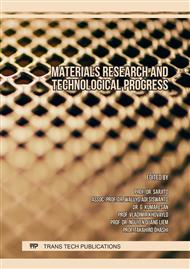[1]
O. M. Yaghi, M. J. Kalmutzki, and C. S. Diercks, Introduction to reticular chemistry: metal-organic frameworks and covalent organic frameworks.
DOI: 10.1002/9783527821099
Google Scholar
[2]
A. J. Howarth, A. W. Peters, N. A. Vermeulen, T. C. Wang, J. T. Hupp, and O. K. Farha, Best practices for the synthesis, activation, and characterization of metal−organic frameworks,, Chemistry of Materials, vol. 29, no. 1. American Chemical Society, p.26–39, Jan. 10, 2017.
DOI: 10.1021/acs.chemmater.6b02626
Google Scholar
[3]
H. Furukawa, K. E. Cordova, M. O'Keeffe, and O. M. Yaghi, The Chemistry and Applications of Metal-Organic Frameworks,, Science (1979), vol. 341, no. 6149, p.1230444, 2013,.
DOI: 10.1126/science.1230444
Google Scholar
[4]
J. Lee, O. K. Farha, J. Roberts, K. A. Scheidt, S. T. Nguyen, and J. T. Hupp, Metal– organic framework materials as catalysts,, Chemical Society Reviews, vol. 38, no. 5, p.1450, 2009,.
DOI: 10.1039/b807080f
Google Scholar
[5]
N. Hanikel, M. S. Prévot, and O. M. Yaghi, MOF water harvesters,, Nature Nanotechnology, vol. 15, no. 5, p.348–355, 2020,.
DOI: 10.1038/s41565-020-0673-x
Google Scholar
[6]
Riki J. Drout, Lee Robison, Zhijie Chen, Timur Islamoglu, and Omar K. Farha, Zirconium Metal–Organic Frameworks for Organic Pollutant Adsorption,.
DOI: 10.1016/j.trechm.2019.03.010
Google Scholar
[7]
I. Abánades Lázaro and R. S. Forgan, Application of zirconium MOFs in drug delivery and biomedicine,, Coordination Chemistry Reviews, vol. 380, p.230–259, 2019,.
DOI: 10.1016/j.ccr.2018.09.009
Google Scholar
[8]
L. Wang, M. Zheng, and Z. Xie, Nanoscale metal-organic frameworks for drug delivery: A conventional platform with new promise,, Journal of Materials Chemistry B, vol. 6, no. 5. Royal Society of Chemistry, p.707–717, 2018.
DOI: 10.1039/c7tb02970e
Google Scholar
[9]
X. Chen et al., Formulation of Metal-Organic Framework-Based Drug Carriers by Controlled Coordination of Methoxy PEG Phosphate: Boosting Colloidal Stability and Redispersibility,, J Am Chem Soc, vol. 143, no. 34, p.13557–13572, Sep. 2021,.
DOI: 10.1021/jacs.1c03943.s011
Google Scholar
[10]
I. Abánades Lázaro, S. Haddad, S. Sacca, C. Orellana-Tavra, D. Fairen-Jimenez, and R.S. Forgan, Selective Surface PEGylation of UiO-66 Nanoparticles for Enhanced Stability, Cell Uptake, and pH-Responsive Drug Delivery,, Chem, vol. 2, no. 4, p.561– 578, Apr. 2017,.
DOI: 10.1016/j.chempr.2017.02.005
Google Scholar
[11]
J. Yang, C. A. Trickett, S. B. Alahmadi, A. S. Alshammari, and O. M. Yaghi, Calcium l- Lactate Frameworks as Naturally Degradable Carriers for Pesticides,, J Am Chem Soc, vol. 139, no. 24, p.8118–8121, 2017,.
DOI: 10.1021/jacs.7b04542
Google Scholar
[12]
S. Wang et al., A robust zirconium amino acid metal-organic framework for proton conduction,, Nature Communications, vol. 9, no. 1, 2018,.
Google Scholar
[13]
S. D. Taherzade, J. Soleimannejad, and A. Tarlani, Application of metal-organic framework Nano-MIL-100(Fe) for sustainable release of doxycycline and tetracycline,, Nanomaterials, vol. 7, no. 8, Aug. 2017,.
DOI: 10.3390/nano7080215
Google Scholar
[14]
S. Rapti et al., Rapid, green and inexpensive synthesis of high quality UiO-66 amino-functionalized materials with exceptional capability for removal of hexavalent chromium from industrial waste,, Inorganic Chemistry Frontiers, vol. 3, no. 5, p.635–644, May 2016,.
DOI: 10.1039/c5qi00303b
Google Scholar
[15]
S. S. Sandhu et al., Green MIP-202(Zr) Catalyst: Degradation and Thermally Robust Biomimetic Sensing of Nerve Agents,, J Am Chem Soc, vol. 143, no. 43, p.18261–18271, Nov. 2021,.
DOI: 10.1021/jacs.1c08356.s001
Google Scholar
[16]
K. E. Diab, E. Salama, H. S. Hassan, A. Abd El-moneim, and M. F. Elkady, Biocompatible MIP-202 Zr-MOF tunable sorbent for cost-effective decontamination of anionic and cationic pollutants from waste solutions,, Scientific Reports, vol. 11, no. 1, Dec. 2021,.
DOI: 10.1038/s41598-021-86140-2
Google Scholar
[17]
Q. Qian et al., Mixed-Matrix Membranes Formed from Imide-Functionalized UiO-66-NH2 for Improved Interfacial Compatibility,, ACS Applied Materials and Interfaces, vol. 11, no. 34, p.31257–31269, Aug. 2019,.
DOI: 10.1021/acsami.9b07500
Google Scholar
[18]
A. H. Ibrahim et al., Tuning the Chemical Environment within the UiO-66-NH2 Nanocages for Charge-Dependent Contaminant Uptake and Selectivity,, Inorganic Chemistry, 2019,.
DOI: 10.1021/acs.inorgchem.9b01611.s001
Google Scholar



